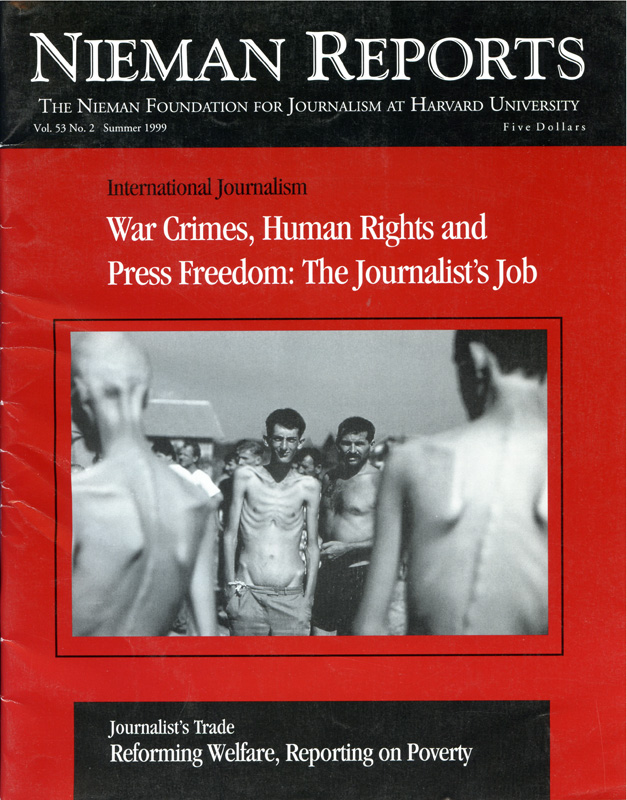In this issue, reviews of books will mingle with reflections from authors, journalists and other observers about ways in which members of the media report on events of our time.
There is perhaps no topic that so dominated the U.S. media’s attention during the past year than what former Executive Editor of TIME, John Stacks, calls “the Monica thing.”
In our lead review, Richard Harwood, a former ombudsman at The Washington Post, assesses the findings and suggestions of two veteran journalists, Bill Kovach and Tom Rosenstiel. In their new book, “Warp Speed: America in the Age of Mixed Media,” these journalists examine how news about this scandal was reported and what impact such coverage is having on the practice of journalism.
Following this review, John Stacks, who is writing a biography of former New York Times Washington Bureau Chief Scotty Reston, contemplates the different way in which coverage of “the Monica thing” might have been handled during his era. Then we hear from PBS “NewsHour” Anchor Jim Lehrer, who found in the midst of this coverage reason to worry about the future of his chosen profession. In remarks he made at a dinner hosted by the International Center for Journalists, Lehrer observed that “Journalism, as practiced by some, has become akin to professional wrestling—something to watch rather than to believe.” Richard Fox, a political science professor at Union College, watched such a wrestling match, along with student Adam-Paul Smolak, as members of the press questioned Reverend Jesse Jackson after a speech he gave in honor of Black History Month. What they heard—“the vapid and obsessive questioning of the journalists”—and how each reacted to it is the subject of our next reflection.
Two more book reviews follow. Josh Getlin, a national correspondent for The Los Angeles Times, peers inside the pages of Neal Gabler’s book, “Life the Movie: How Entertainment Conquered Reality,” and uncovers evidence that news reporting is moving into “the Republic of Entertainment.” And former Los Angeles Times Washington Bureau Chief Jack Nelson reflects on Max Frankel’s autobiographical look at his life and his career at The New York Times. Nelson concludes that Frankel’s memoir is “a journalism classic and a compelling read not just for media junkies, but for a general audience.”
There is perhaps no topic that so dominated the U.S. media’s attention during the past year than what former Executive Editor of TIME, John Stacks, calls “the Monica thing.”
In our lead review, Richard Harwood, a former ombudsman at The Washington Post, assesses the findings and suggestions of two veteran journalists, Bill Kovach and Tom Rosenstiel. In their new book, “Warp Speed: America in the Age of Mixed Media,” these journalists examine how news about this scandal was reported and what impact such coverage is having on the practice of journalism.
Following this review, John Stacks, who is writing a biography of former New York Times Washington Bureau Chief Scotty Reston, contemplates the different way in which coverage of “the Monica thing” might have been handled during his era. Then we hear from PBS “NewsHour” Anchor Jim Lehrer, who found in the midst of this coverage reason to worry about the future of his chosen profession. In remarks he made at a dinner hosted by the International Center for Journalists, Lehrer observed that “Journalism, as practiced by some, has become akin to professional wrestling—something to watch rather than to believe.” Richard Fox, a political science professor at Union College, watched such a wrestling match, along with student Adam-Paul Smolak, as members of the press questioned Reverend Jesse Jackson after a speech he gave in honor of Black History Month. What they heard—“the vapid and obsessive questioning of the journalists”—and how each reacted to it is the subject of our next reflection.
Two more book reviews follow. Josh Getlin, a national correspondent for The Los Angeles Times, peers inside the pages of Neal Gabler’s book, “Life the Movie: How Entertainment Conquered Reality,” and uncovers evidence that news reporting is moving into “the Republic of Entertainment.” And former Los Angeles Times Washington Bureau Chief Jack Nelson reflects on Max Frankel’s autobiographical look at his life and his career at The New York Times. Nelson concludes that Frankel’s memoir is “a journalism classic and a compelling read not just for media junkies, but for a general audience.”



